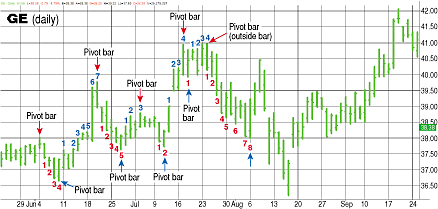The Logic Of Pivot Trading
This methodology takes advantage of the short-term trends in the market and applies a pivot trading technique to earn superior returns.
IN 1998 I wrote a paper that became the foundation of a trading methodology I refer to as pivot trading. This methodology takes advantage of a fundamental characteristic of freely traded markets -- that is, the persistence of price movement. This article will describe the underlying logic of the methodology, provide an example of the statistical verification of persistence, and outline how traders can use it to their advantage.
WHAT IS PERSISTENCE?
Persistence is the tendency of a market to move in one direction over a period of time before reversing course. The movements can also be referred to as runs or short-term trends. Those who claim that markets are random admit to the existence of persistence but explain it as a consequence of run theory, where each day has an equal probability of being up or down and the probability of continuing a run declines as the run gets longer. These market participants believe there is no feedforward of information from one day's activity to influence a future day's activity.

I, however, believe that market movements are the result of knowledgeable participants reacting to information impulses and trading accordingly. In this view, market persistence is an expression of the sentiment of market participants over a period of time. Participants make conscientious decisions to buy and sell and are influenced by previous activity.
...Continued in the November issue of Technical Analysis of STOCKS
& COMMODITIES
Excerpted from an article originally published in the November 2008 issue of Technical Analysis of STOCKS & COMMODITIES magazine. All rights reserved. © Copyright 2008, Technical Analysis, Inc.
Return to November 2008 Contents